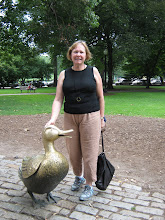I know it is not August, but while shelving, weeding and tidying the shelves this week because it is the last week of school at my Australian school, I noticed how many picture books feature goldfish. I then wondered if there was a day to celebrate goldfish on which we could do a display because we haven't done one before. Well there is. It is the 2nd August, so I'm writing now so I don't forget to do a display next year.
Some teachers have a goldfish in their classroom and they will often come and ask for a book to read to their class. Everyone knows • A Fish Out of Water by Helen Palmer A little boy who overfeeds his goldfish begins an adventure that brings even the police and a fire engine to cope with a fish out of water.
But, I like to give them one that they may not know and that is humorous or informative such as:
• Who Fed Zed? by Amelia McInerneyZed the fish is white and red.
His poo hangs down in one long thread.
The main thing, though, is what Fred said,
'NEVER, EVER FEED ZED BREAD.'
• We Don't Lose Our Class Goldfish by Ryan T. HigginsPenelope Rex has one fear- Walter, the class goldfish. So when Mrs. Noodleman tells the kids that they'll be taking turns bringing Walter home, Penelope gets carried away by her anxious imagination.
• Something's Fishy by Kevin McCloskey Some fish breathe air and some fish fly, but the most wonderful fish of all turns out to be the one you've got at home.
• My Pet Goldfish by Catherine RaynerThe child narrating this story has been given their first ever pet: a tiny fish with shimmering scales and bright beady eyes… Their very own goldfish! Sitting alongside the gentle narrative and dynamic illustrations, the subtext introduces facts about goldfish and their care – some gentle, some funny, some fascinating.
• Poor Fish! by Jane GodwinIt's Saturday morning. Auskick starts soon. But there's something wrong with Brendan's fish.
Then these are the others I could choose from:
And if you are looking for short chapter books try these:









































































